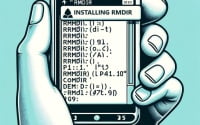What is RAID 0? — RAID striping explained
RAID – or “Redundant Array of Independent Disks” – is a strategy for data storage used on most server setups. Understanding how RAID works, how it can help you meet the needs of your business or organization, and understanding differences between RAID levels is important before setting up your server. This article discusses RAID 0 and other RAID configurations in detail, so if you want to know if RAID 0 or another type of RAID can work for you, read on.
Table of Contents
What is RAID?
“Redundant Array of Independent Disks” is the technical term for a set of hard disks that are configured to work together as a single drive (known as an “array”). Most RAID types store multiple copies of data across each disk in the array in a way that helps ensure data security (the “redundancy”), and sometimes increase disk performance, depending on the RAID type. Different RAID types offer different layouts of data redundancy – often explained in terms like “mirroring,” “striping,” “parity,” and “nesting”. Each has a different effect on the speed at which data is accessed and written onto the array.
RAID 0, the focus of this article, is unique among RAID types in that it offers neither data redundancy (multiple copies of data) nor “parity” information (a key for reconstructing lost data). You may be wondering what, then, RAID 0 is used for. While RAID 0 is not appropriate for all situations, it does have its place in certain applications. But before we discuss that…
Are you sure I need to setup RAID on my server?
Hard drives, like it or not, fail often. Restoring a drive from a backup (if there is one) takes a lot of time – a valuable resource in a digital business environment where consistent online availability is crucial for success. Setting up a server with RAID will help you avoid costly downtime, as most RAID types keep multiple, actively updated copies of your data ready to step in if (and when) disk failure strikes. Moreover, RAID can help you save disk space, maintain the integrity and quality of your data, and increase server performance.
RAID Levels
“RAID levels,” or different configurations of RAID, organize your data differently depending on the way your data is used and accessed. This article discusses RAID 0, which in server applications is most often combined with other RAID configurations due to its lack of data redundancy (sometimes referred to as “nested” RAID).
RAID 0 contrasts from other RAID types in that it does not offer data redundancy, neither through “mirroring” (complete copies of data on each disk in the array) nor “parity” (striping of data spread across each disk alongside a drive with data that can help reconstruct a lost drive). Instead, RAID 0 “stripes” one set of data across two or more disks, linking the data in such a way that if one drive is lost, all the other data is lost, too. This makes RAID 0 impractical and potentially dangerous for singular use in a server setup, and is better used in conjunction with some form of data redundancy.
Because each RAID type offers varying degrees of capacity, protection, and performance, it’s important to understand how each type works before making a selection for your server.
So should I use RAID 0?
To answer this question, it helps to understand your alternatives. Imagine your data as a sandwich: RAID 0 slices that sandwich in half (or any number of equal portions) and puts each half into two different lunch boxes (disks) linked up by a chain. In order to enjoy your lunch, you need both halves of the sandwich; but with RAID 0, if you lose one lunchbox, you lose both and your entire lunch is ruined. This also means that the more lunchboxes and sandwich segments you have, the higher the risk of ruining your lunch.
In contrast, a configuration like RAID 1 offers data “mirroring”, in which two (or more) identical sets of data are stored on a group of arrayed drives. They still function as a unit, but if one drive fails, any one of the other “mirrored” drives can step in instantly, as any data written to one drive is written to all drives in the array. In this case, you have multiple, identical sandwiches – so it’s no big deal if you lose just one. You’ll still get to enjoy your lunch.
Another configuration, RAID 5, stripes data across multiple disks like RAID 0 but with one important difference – it requires one extra drive onto which it writes “parity” data, a special set of instructions that in most cases allows reconstruction of a lost portion of your data sandwich. Think of “parity” data like a set of ingredients that allows you to re-make the lost part of your sandwich (see our article on RAID 5 for a more detailed discussion of how data parity works).
Because RAID 0 does not use data redundancy or parity information, its performance is usually faster, as there is no need to write the same data across multiple drives nor the need to create parity information. But this also runs a higher risk of complete data loss.
Despite the higher speed and performance, RAID 0 should really only be used in conjunction with another RAID type that offers redundancy or parity of data (or possibly in an application that demands high performance but little need for data reliability, such as gaming or graphics processing). This is known as “nested” RAID. RAID 10, for example, is a combination of RAID 0 and RAID 1. In this type, the entire dataset is first split into equal parts using RAID 0. Then, each part is organized into sub-configurations of RAID 1 – meaning each part of your data sandwich has one (or more) drives with multiple copies of each portion of data. In other words, for the entire array to fail, all the mirrored drives in one of the RAID 1 segments would have to fail. RAID 10 offers some of the performance benefits of RAID 0, but the relative safety of RAID 1.
Web hosting servers usually use RAID 5, 6, or 10 because they strike a nice balance between speed and data integrity. Have a look at our articles on RAID 5 and RAID 10 for more information on these types.
How RAID 0 works
RAID 0, like RAID 1, requires only two drives to work properly. As mentioned previously, data is split into equal parts and “striped” across multiple drives, often in 64 kB blocks. The constituent stripes of data stored on one disk are in effect linked to stripes of data on other disks in the array, which is why you lose all your data if any one disk in the array fails.
Benefits of RAID 0
- RAID 0 offers high performance and quick data read/write speeds (provided the disks in the array are operational).
- If used on its own, requires only two disks in the array, much like RAID 1.
- Can be effectively combined (or “nested) with other RAID types to improve server performance while maintaining data integrity (such as with RAID 10)
Drawbacks of RAID 0
- -Has no tolerance for drive failure due to the lack of parity information and mirroring.
- The more disks you include in the array, the more likely you are to have a complete loss of data. So if you want more capacity, you’ll have to accept higher risk.
- The capacity of each disk is limited to the size of the smallest disk in the array. In other words, if you have a 100GB drive and a 300 gB drive, your total storage space would only be 200GB (100GB x 2).
- If data integrity and safety is your goal, not an acceptable choice of RAID.
More questions about RAID?
This article covered RAID 0 and its relationship to other RAID types. If you still feel a little uncertain about how RAID works, have a look at our other articles or contact us for more information.
If you’d like an easy way to get started with a RAID-enabled dedicated server, IOFLOOD.com would be glad to help. Contact us today to see if an IOFLOOD server is right for you.


